Content [show]
Whether we like it or not, IPA (Indian pale ale) has become synonymous with American craft beer. These fruity hop bombs are known for their intense bitterness, high alcohol content and heady hop aroma. They also inspired the hopping of nearly every traditional beer style, from seasonal and Scottish ales to pilsners and porters.
Overall, IPA is the most popular style of craft beer, accounting for nearly 30% of annual sales - over 150 million gallons of beer consumed annually. There are over a dozen different subgenres of this style, with new ones appearing almost every year, not to mention the various variations that the smaller breweries are releasing one by one, unable to stop. This guide, created by Lucky Peach Magazine, will help you determine what to expect from an IPA in your glass.
 India Pale Ale. Art by Tyler Gross
India Pale Ale. Art by Tyler Gross
Classic IPA
American IPA
What we consider to be a modern American IPA today has its roots in Chico, California, where Sierra Nevada Pale Ale was brewed in the early 1980s. Of course, this variety was not nominally an IPA yet, and there were other hoppy American ales that predated it - notably Anchor Brewing Co.'s Liberty Ale. and Ballantine IPA. However, Sierra Nevada Pale Ale's bright, citrusy hop aroma is a model for all modern American IPAs that have since emerged. For distinctive bitter and hoppy American IPAs, New World hops such as Columbus, Chinook, and Citra are used, which give the beer aromas of resin, pine needles and tropical fruits, as opposed to the herbaceous and spicy aromas of British and German hops. American IPAs tend to be less malty than original UK IPAs, have a dry finish and a crisp, clean fermentation profile.
Worth Trying: Bell's Two Hearted Ale, Cigar City Jai Alai, Wicked Weed Pernicious IPA.
English IPA
The original English IPAs are believed to have been brewed with copious amounts of hops as a preservative for shipping beer to India by sea. In the meantime, there are many myths (and, frankly, nonsense) about the origins of the style, one can only imagine that historically this variety (if it actually traveled around the Cape of Good Hope in wooden barrels) tasted the same as typical modern English. IPA. The style is characterized by the gentle, herbal bitterness of English hops such as Fuggle and Goldings, and a pronounced maltiness that is often lacking in American IPAs. The varieties of this style typically contain between 5% and 7.5% alcohol.
Worth Trying: Meantime IPA, Green Man IPA, Fuller's IPA.
Double IPA
A distinctive feature of the double IPA is its pronounced hop bitterness. It is often accompanied by a strong malt flavor, which means a higher proportion of fermentable sugar, resulting in a higher body and higher alcohol content (typically 8% to 10%). Like American and West Coast IPAs, this style is intensely hoppy and bitter, but with some residual sweetness and added complexity.
Worth Trying: Stone Enjoy By IPA, Hill Farmstead Abner, Toppling Goliath King Sue.
Imperial IPA
Basically the same as DIPA, but with an alcohol content of 11% or more. Beer with amazing aroma.
Worth Trying: Alpine Exponential Hoppiness, Other Half All Green Everything, Evil Twin Molotov Cocktail.
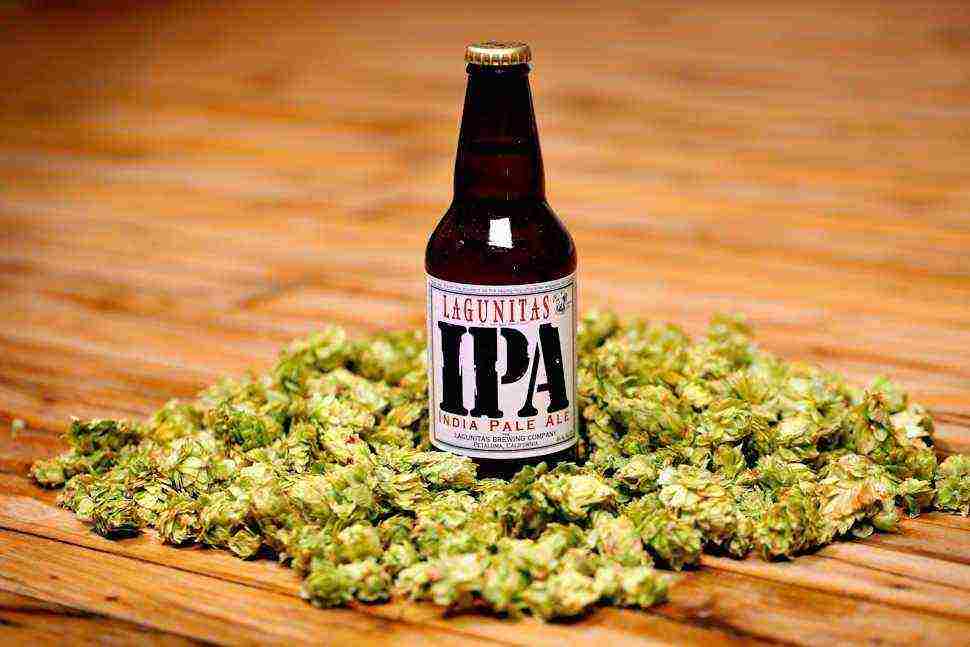 Lagunitas IPA. Photo: The Huffington Post
Lagunitas IPA. Photo: The Huffington Post
Regional IPAs
West Coast IPA
At the moment, this style is more of a definite idea than a geographical designation. The creators of the West Coast IPA have taken American Pale Ale as a basis and increased the level of hops, alcohol and bitterness. Now this beer is brewed all over the world, but this style most likely originated in Southern California, where breweries such as Stone, AleSmith and Ballast Point flourished in the mid-90s. The style is distinguished by invigorating bitterness and juicy citrus aroma.
Try it: Pizza Port Solana Beach Swami's IPA, Lagunitas IPA, Russian River Blind Pig IPA.
Belgian IPA
While there are a couple dozen beer styles typical of Belgium, IPAs are certainly not one of them.In fact, it was not popular there until the early 2000s, when American brewers began to make a notable influence in the craft brewing world. But now Belgian brewers are adopting American-style hop beers that are brightened and pungent by the fruity, spicy aromas of Belgian yeast - the Belgian IPA is also a subcategory of the Beer Judge Certification Program. IPAs in this style, whether made in Belgium or the States, are made with Belgian ester-producing yeast that gives the beer a persistent banana, pear, and clove aroma (like Hoegaarden), which, on the other hand, is sometimes paired with the same persistent hop aroma. Most Belgian IPAs are pretty strong at around 8%.
Worth Trying: Green Flash Le Freak, Brasserie d'Achouffe Houblon Chouffe Dobbelen IPA Tripel, Allagash Hugh Malone.
Vermont-style IPA
Vermont has more microbreweries per capita than any other state, so it's no surprise that many of the coolest beers are brewed there. Surprisingly, despite the very small number of hop producers, some of the most popular and delicious IPAs in the world are made here. Vermont style is more fruity and significantly less bitter than the West Coast IPA. This is due to the addition of more hops after the wort has cooled, rather than during brewing, which makes the beer more drinkable. Most varieties of this style are brewed in small quantities, which, combined with high demand for them, has even led to the growth of the black market. Most Vermont brewers would not name their own beers Vermont-style IPA - only outside the state they distinguish this style with many distinct characteristics, but in Vermont itself it would be called simply IPA.
Worth Trying: The Alchemist Heady Topper, River Roost Mas Verde, Lawson's Double Sunshine IPA.
Northeast-style IPA
Whether this style is strongly influenced by nearby Vermont breweries is debatable. Northeastern-style IPAs are unusually soft and juicy, with strong hop aromas of grapefruit, tangerine, pineapple and melon, but almost no bitterness (due to late hopping). They are usually cloudy - some brewers are said to add flour to enhance this effect. Most likely, to buy such a beer, you will have to stand in a long queue. Some of these varieties taste like ice cream on a stick, while others are stronger and more heady. Many are made using a blend of American and Australian hops and, like the Vermont-style IPA, come in aluminum cans with bright, colorful labels. Since they are unfiltered and have an ephemeral hop rate, they usually expire within a few weeks. Although very few breweries define their beers as Northeast-style IPAs, this is increasingly seen on cans and menus.
Worth Trying: Tree House Julius, Bissell Brothers The Substance, Trillium Congress Street IPA.
Black IPA
A real oxymoron (do you remember that P in IPA stands for pale?). Black IPA is another style that still needs to be emphasized. Also known as Cascadian dark ale, it probably originated in the Cascade Mountains region of the Pacific Northwest. It is dark, damp and strong, like a mossy forest strewn with pine cones. The charcoal color of the beer comes from roasted malt, like the one used at Guinness.
Worth Trying: Firestone Walker Wookey Jack, To Øl Black Malts & Body Salts, 21st Amendment Back in Black.
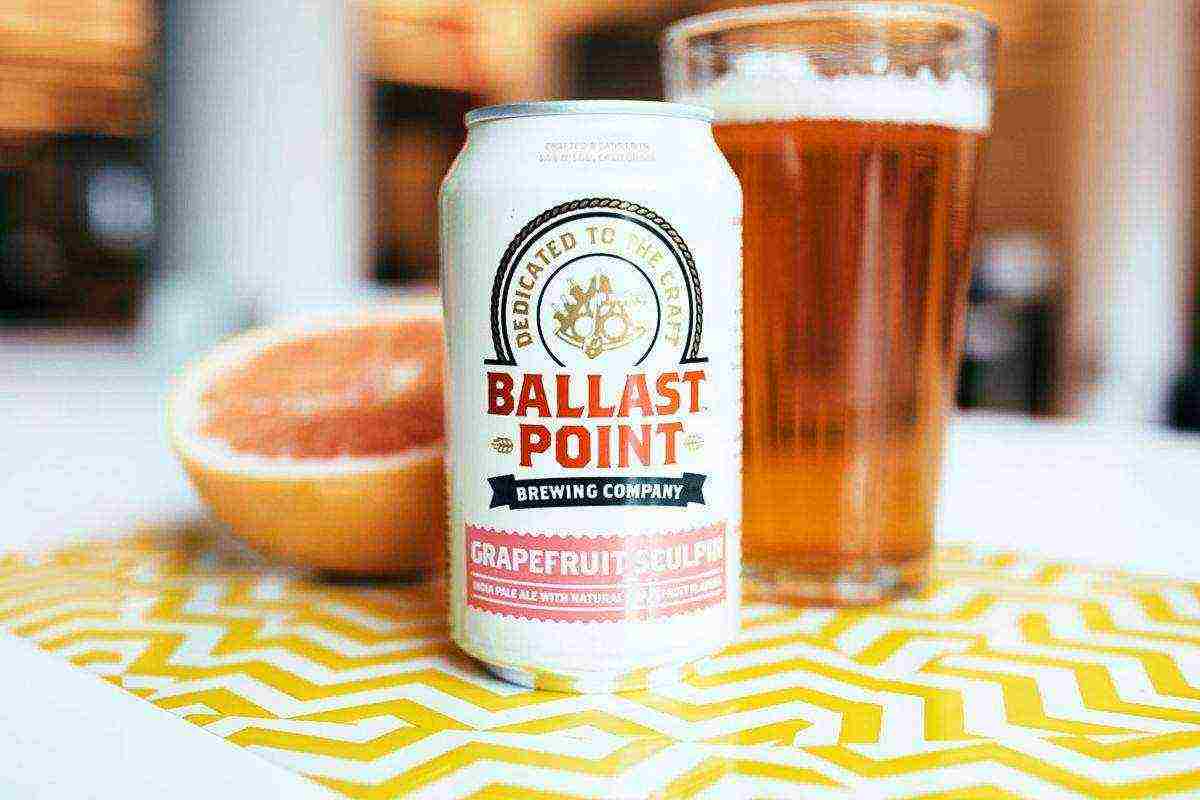 Ballast Point Grapefruit Sculpin. Photo: Josh Rubin
Ballast Point Grapefruit Sculpin. Photo: Josh Rubin
Other IPAs
Session IPA
These varieties, which have appeared on the market in the last five years, are brewed in small batches, but have an excellent taste. They have a pronounced double IPA hop character, but they have half the alcohol content (less than 5%) so you can enjoy them throughout the day without getting too drunk. Many are poorly brewed and aptly described by connoisseurs as "hop water", but the style has nevertheless become extremely popular, especially among daytime drinkers in the fresh air. The best of them are dense, with a tropical fruity aroma and a clean but persistent aftertaste.
Worth Trying: Firestone Walker Easy Jack IPA, Carton Boat Beer, Maine Beer II.
Citrus IPA
San Diego-based Ballast Point Brewing & Spirits made the style popular in 2014 by adding grapefruit to their signature Sculpin IPA to enhance the grapefruit notes found in West Coast hops. These aromas come from the essential oils found in hops, which give the beer a bouquet of citrusy and tropical fruit aromas. Now everyone is experimenting with citrus fruits, from Samuel Adams to the smallest nanobrewers. What is the result? It's not always the same. Done right, citrus enhances the beer, blending easily with it and accentuating the fruity aromas of the hops. If done poorly, beer can taste rough and artificial.
Worth Trying: Ballast Point Grapefruit Sculpin, Hop Valley Citrus Mistress, Magic Hat Electric Peel.
Brett IPA
Like citrus fruits, Brettanomyces yeast is popular in the craft brewing world. This wild yeast variety, called Brett for short, is closely related to the domesticated yeast used by brewers for centuries. For most of brewing history, Brett has been perceived as a defect in beer - only lambic, gueuze, and some seasonal varieties have welcomed the earthy, wild notes that yeast imparts.
Most IPA strains do without the pungent Brett scent, but some of them only get better thanks to the complex flavors of this yeast not found in "pure" strains. Brett IPA is one of the few styles that can only get better over time. It should be noted that Brett does not make beer "sour" (this is the work of bacteria such as Lactobacillus and Pediococcus, which are often used in combination with Brett).
Worth Trying: Anchorage Galaxy White IPA, Austin Street Brett Loves Hops, Crooked Stave Hop Savant.
Fresh hop IPA
Fresh or wet hop IPAs are brewed in the fall at the end of the hop harvest. Fresh green hops are harvested and, without allowing them to dry, are immediately added to the beer. In this way, oils and resins are preserved, which disappear immediately after the hop cones are plucked from the branches. Imagine the difference between using fresh or dried herbs in a dish: fresh oregano tastes one thing and dried oregano tastes different.
Freshly hopped beer retains its brightness and freshness for only a few weeks, after which the hop aromas fade. Because of this, their production is not widespread.
Worth Trying: Sierra Nevada Harvest Wet Hop IPA, Bale Breaker Citra Slicker Wet Hop IPA, Fort George Fresh IPA.
India pale lager
IPLs are technically not IPAs, but they have so many similarities with the style that it's hard not to include them on this list. IPLs are clean and sparkling, with less ester and yeast aromas than IPAs, so perhaps the hop character is more pronounced. However, some critics argue that this is just another example of the American drive to increase hop proportions in all beer styles.
Worth Trying: Jack's Abby Hoponius Union, Wolverine State Gulo Gulo IPL, The Bruery Humulus Lager.
Pivo.by comment: The division into Double IPA and Imperial IPA used by the authors of the article is not correct. In the BJCP Beer Judge Certification Program and BA Classifier, the style names Double IPA and Imperial IPA are considered synonymous. Those beers that are listed as Imperial IPA in the article are categorized as Double IPA / Imperial IPA. They are also sometimes categorized into a new category - Triple IPA, although this has not yet been enshrined in professional beer style guides.
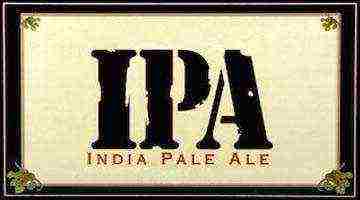 Foam drink lovers who first come across the abbreviation in the name of the beer "IPA" are misleading by its decoding - India Pale Ale. In fact, this is a classic British pale ale that is pretty hoppy. Although, it is also directly related to India, since its original recipe was created taking into account the taste preferences of the inhabitants of the English colonies, as well as the conditions for transporting the finished drink over long distances.
Foam drink lovers who first come across the abbreviation in the name of the beer "IPA" are misleading by its decoding - India Pale Ale. In fact, this is a classic British pale ale that is pretty hoppy. Although, it is also directly related to India, since its original recipe was created taking into account the taste preferences of the inhabitants of the English colonies, as well as the conditions for transporting the finished drink over long distances.
History of creation
It is reliably known that IPA was first brewed at the beginning of the 19th century - around 1829 in the city of Burton upon Trent, which during the period described was considered the beer capital of the British Isles. However, some beer historians - the chroniclers of brewing - claim that India Pale Ale appeared much earlier, for which there is no documentary evidence at the moment. The basis for the creation of the drink was the hopped October ale, which was very popular among British citizens.
Brewers were looking for ways to deliver the foamy drink to distant shores, in which it would not lose its original quality, because high temperatures and constant pumping did not affect the properties of beer in the best way. Therefore, changes were regularly made to the recipe in order to increase the product's resistance to adverse factors.
As a result of such experiments and the IPA beer appeared, a distinctive feature of which was the increased hop content... Brewers have noticed that this has a beneficial effect on the safety of the foamy drink during transportation, since hops play the role of a natural preservative. The taste of the resulting variety corresponded to the hot and humid climate of India - such a drink quenched thirst better than the sweet porters popular at that time. In addition, it could be drunk without fear of getting poisoned, as was the case with the use of local water.
The beer of those years was distinguished by a very high level of bitterness, which protruded in the taste immediately after preparation. This was compensated for only by a short time for the destruction of hop products in the finished drink. Thus, ale could be drunk calmly only at the end of his long journey. In addition, the drink was quite strong, with a standard alcohol content ranging from 8 to 12%.
At the beginning of the 20th century, the transport speed increased and the level of hygiene stepped to a new level even in the third world countries. In addition, lagers were gaining fashion, the varieties of which were produced in increasing quantities at that time. In such conditions, the popularity of IPA faded away - India Pale Ale was practically discontinued. Interest in the variety revived only in the 80s of the last century.when the owner of a private brewery in California revived and refined the classic recipe. It was from the USA that the IPA began its re-conquest of beer lovers. Soon, the updated drink reached Britain, where they remembered the roots of the variety. Every brewer now considered it his duty to create his own variation of the undeservedly forgotten drink.
Features of preparation and taste
The peculiarities of making IPA, first of all, include a large amount of hops. Actually, this is its main difference from the usual pale English ale. However, a truly good brew can only be brewed by a skilled brewer. The point is the hops - the one that is added at the very beginning of the beer brewing gives less aroma and more bitterness. Wherein, Hops added at the very end of the boil work in the opposite direction. In some cases, "dry hopping" is used, when dry hops are also added at the end of boiling directly into the tank for a period from several days to several weeks. The mastery of the brewer here is to achieve the maximum level of harmony in taste and aroma.
Modern IPAs, unlike 19th century beers, can be consumed immediately after brewing. Moreover, many brewers insist on drinking it as soon as possible, noting the fact that only a fresh drink retains its full flavor and aroma. Of course, each rule has its exceptions.
The bitterness of beer is usually measured in international units of bitterness - IBU. You can read more about this in THIS article. on our website. Bitterness values for IPA average between 40 and 60 IBU. In the case of Double India Pale Ale, this figure can go up to 100 IBU... Of course, the boundaries are pretty blurry, and every single brewer can see them differently!
IPA varieties
Today, IPA beers are brewed primarily in craft breweries. The varieties of hopped ales are countless. But this variety is usually divided into three main groups:
- English;
- American;
- Imperial.
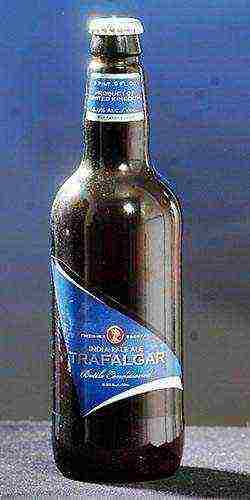 Each type is characterized by its peculiarities: recipe, taste, bouquet, strength. Thus, the English IPA is characterized by light shades of amber-golden color and a lush, stable foam, a moderate hop aroma prevails in the bouquet, as well as blotches of floral and fruity notes - the result of dry hopping.
Each type is characterized by its peculiarities: recipe, taste, bouquet, strength. Thus, the English IPA is characterized by light shades of amber-golden color and a lush, stable foam, a moderate hop aroma prevails in the bouquet, as well as blotches of floral and fruity notes - the result of dry hopping.
The taste of British IPA is dominated by bitterness of hops and a moderate presence of malt.The body of the beer is smooth and light, alcohol is not felt in it, and after consumption, a tart aftertaste with hints of malt remains. Among the popular representatives of English India Pale Ale, the most famous are Freeminer Trafalgar IPA and Fuller's IPA.
The American IPA has an intense hop aroma with distinct citrus notes that are characteristic of the mid-20th century US hop varieties. Certain varieties have some malt weakness, which is much less pronounced compared to English varieties. The color of the drink is rich, close to red copper or dark shades of orange. But at the same time, the beer is transparent, with the exception of certain unfiltered American IPA varieties.
The flavor of American pale ale is best characterized by the definition - balanced. It is not as deep as the English varieties. The base is a hop bitterness against which additional citrus, floral and fruity notes are felt. There is also a sweetness that caramel and lightly toasted malt imparts to the drink. The strength of American IPAs is moderate.
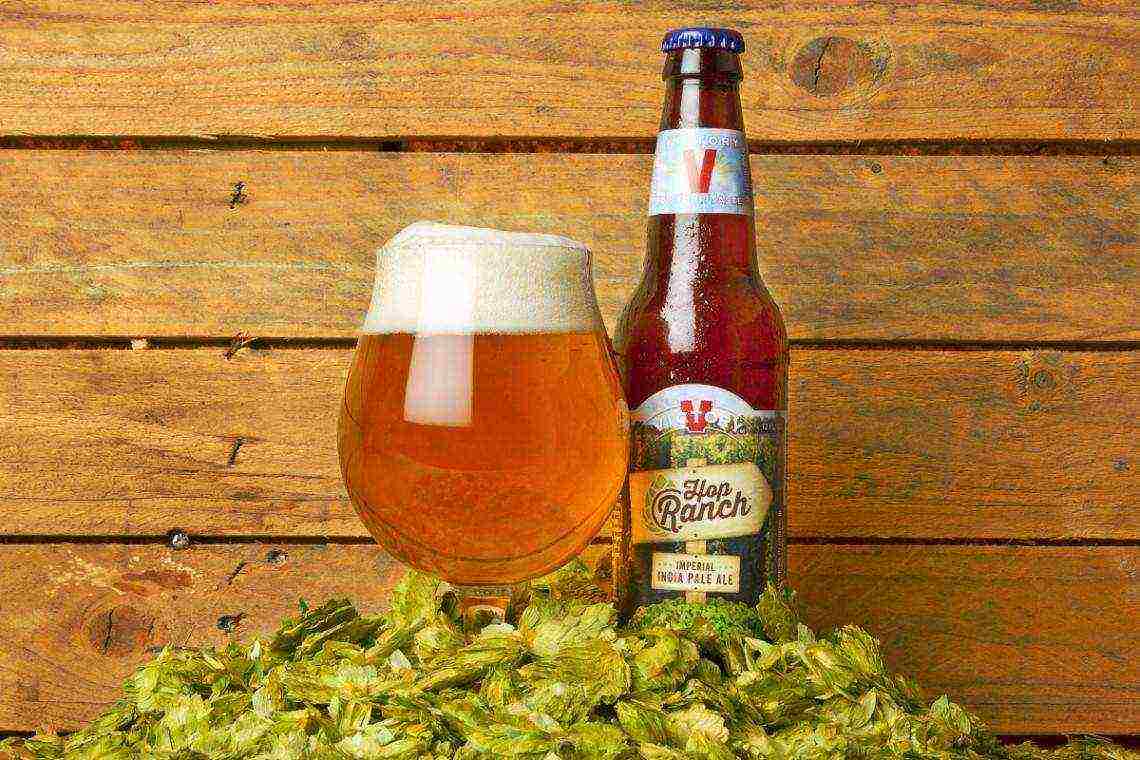
Imperial IPA beers are distinguished by a complex hop flavor and bitterness, which in some varieties exceeds reasonable limits and lasts for a long time even in the aftertaste. This is probably why Imperial IPA is not as popular with India Pale Ale fans... The citrus and fruity notes so characteristic of the English and American varieties are replaced by oak in the imperial IPA. Taken together, this allows the Imperial IPA to be characterized as a strong drink with a deep taste for an amateur. Essentially, Imperial IPA belongs to the American style of brewing, often for its qualities it is called Double IPA or DIPA.
Write in the comments whether you like hoppy beers or do not like bitter beers, and also vote in our group !
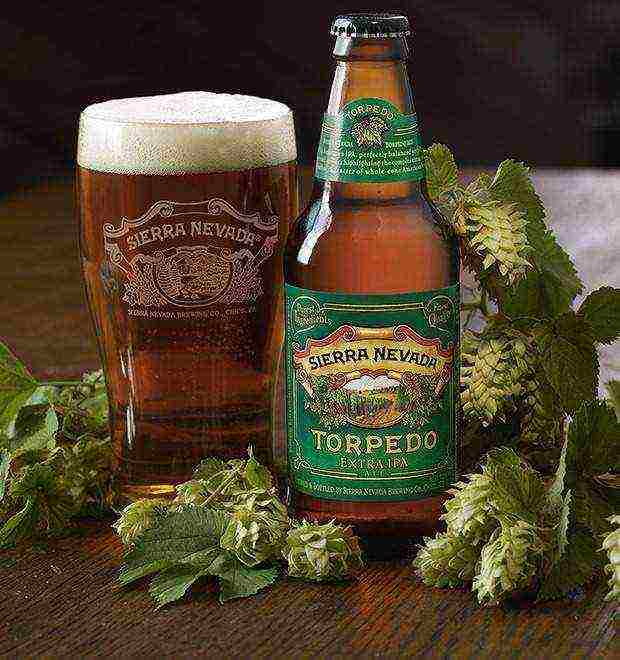 Culture
Culture
A post about IPA. Part two
Last week we published a story about what India Pale Ale is and how it came about. In the continuation of our article, the author of the BeerFreak blog, Alexander Sedov, will talk about what Indian pale ale is today and what it is like.
IPA today
Despite the immense popularity of IPAs in the craft beer community, macro beer has not yet attempted to ride and stifle this beer trend. Perhaps the whole point is that a real IPA is expensive and difficult to produce, plus the mass consumer is not yet ready to accept such a bitter beer, so the beer giants cut cabbage on "lawn lagers" and look to the future with optimism. When it comes to the real IPA world, everything is very good there. At the last World Beer Cup, the most contenders were in the American IPA category - 222. Today, there are three main trends in the development of Indian pale ales:
Extremism
It would seem that the limit of the units of bitterness that a person can feel has already been passed, the range of bouquets is nowhere wider, the degree grows and rolls over, but no, craft brewers stubbornly do not want to stop. Even after Mikkeller brewed his 1000 IBU (the threshold of human perception of bitterness is somewhere between 80-100 IBU), other brewers joined the game, and while the record of 2500 units of bitterness is held by the Alpha Fornication of the Canadian brewery Flying Monkeys. Time will tell, but most likely the crown of this race will be some nine-fold IPA or ice-IPA, from which they will freeze the water (BrewDog has already done something similar with its Sink the Bismark beer, 41%).
Bouquet orientation
More moderate IPAs today are primarily a podium on which any new hop variety can show off, and since hops are now actively bred, carefully and in many parts of the world (Australians and New Zealanders, and especially the Nelson Sauvin variety, achieved particular success a couple of years ago) , brewers will be able to collect new bouquets from existing and new species for a long time to come. It is quite possible that soon the bouquet will become the determining factor in the classification of IPA and the consumer will choose not just Westcoast IPA, but IPA with a unique blend of 4C, Slovak and two New Zealand hops.
Experiment
Experiments with IPA are not standing still either.After the hop bombs reached a certain peak, some brewers took a different route. Now India Pale Ale is undergoing an active experiment, changing its color, yeast, adding additives to it and even making it sour. It is not yet clear how this will end, but now in this experimental chaos it is difficult to single out even one or two distinct substyles.
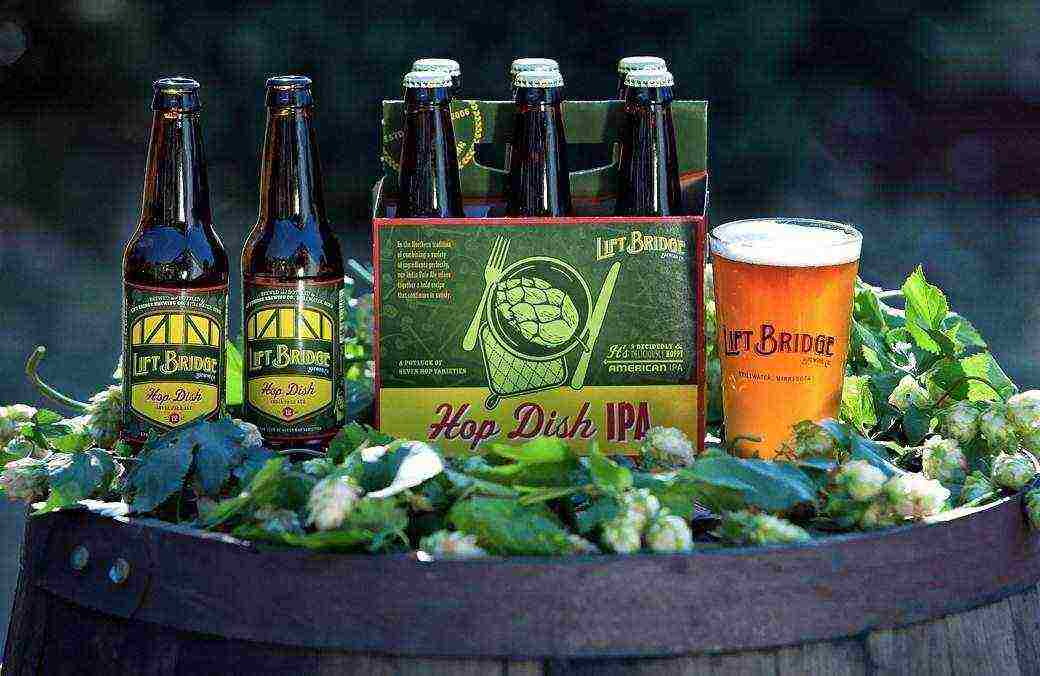
IPA types
British IPA
Despite the name, this is not exactly the original India Pale Ale, but rather a collection of any IPA that is brewed exclusively with British malt and hops. These include reconstituted, historically correct Burton IPAs, session remnants of all hardships and hardships like the Greene King IPA (only 3.6% ABV) and IPA brewed with a modern twist. The weak point of these IPAs is not their heterogeneity, but the hops themselves. British hop varieties are good, of course, but in terms of aromatics they are far behind both the bright American hops and the new wave of Australian and New Zealand hops. This makes British IPAs less impressive, but it doesn't stop brewers from creating interesting and unusual IPAs with a grassy and floral twist.
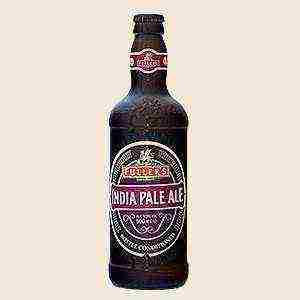
FULLERS INDIA PALE ALE

ST.AUSTELL CORNISH IPA
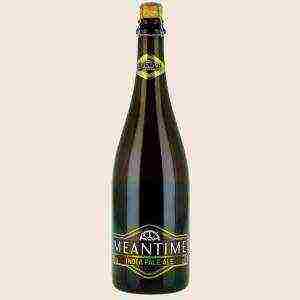
MEANTIME INDIA PALE ALE
American IPA
This variety is the cornerstone of modern India Pale Ale. It is distinctive for its dense malt base, good hopping and strength, not exceeding 7-7.5% degrees. Interestingly, an IPA is considered American even if only one of the bouquet is an aromatic American. This hop is already too strong and unique. Central to this ale is the balance between the sweetness of the malts and the pine-citrus aroma. In the modern paradigm of brewers, there is a joke "No beer - put more hops", and a grain of truth in it makes it clear that the true masters of IPA are those who manage the balance of taste without this approach.
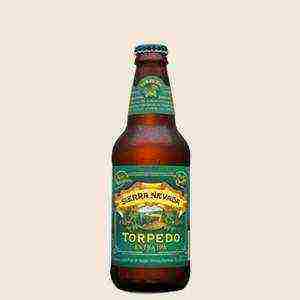
SIERRA NEVADA TORPEDO EXTRA IPA
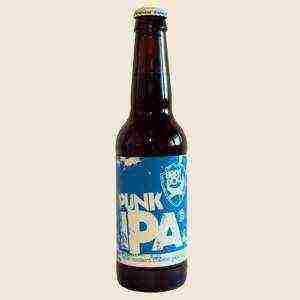
STONE IPA BREWDOG PUNK IPA
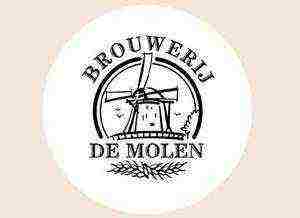
"Since everything is possible, why can't we?" - decided the fans of lagers and got them drunk. Indian pale lager is a fairly young style, but its representatives are in the lines of many US crafters and even Europeans De Molen and Nørgne Ø.
Double / Imperial IPA
It would seem that the American IPA itself has already sufficiently expanded the idea of beer and hops for beer lovers, but no - there were daredevils who were not afraid to go further and began to double, triple and even quadruple the volume of ingredients. Similar experiments appeared in the early 1990s, when even simple IPAs were still considered extreme. And already in 2001, Pliny the Elder, DogfishHead 90 Minute IPA and the fifth anniversary IPA Stone were born, which a year later became the first permanently produced and bottled double or imperial IPA - Stone Ruination. Since San Diego was particularly famous for these ales, double IPAs were often referred to as San Diego Pale Ale.
Double IPAs typically start at 7% and contain huge amounts of predominantly American hops. Today they are conventionally divided into two main subspecies:
- Westcoast IPAs are drier and with an emphasis on hop aroma. A distinctive feature of these IPAs is the aroma hops exclusively from the American Cascade family.
- Eastcoast IPA - This subspecies has a greater emphasis on malt, plus a balance of bitterness and flavor is important.
The very territoriality of new types of hops allows crafters to come up with rather interesting terms like "Pacific IPA" (with Japanese, American and New Zealand hops), but a clear division by geographic or any other hop trait has not yet been accepted.
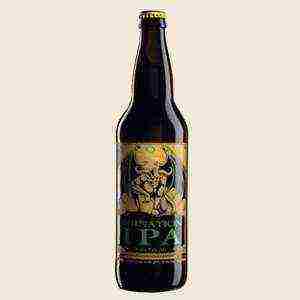
STONE RUINATION IPA
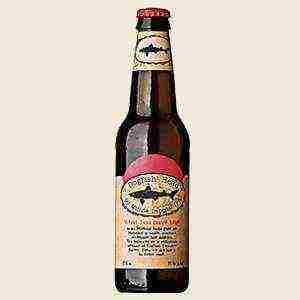
DOGFISHHEAD 90 MINUTE IPA
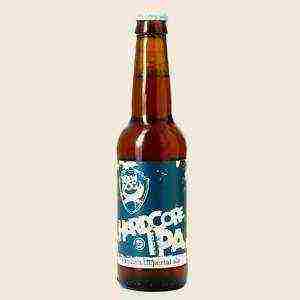
BREWDOG HARDCORE IPA
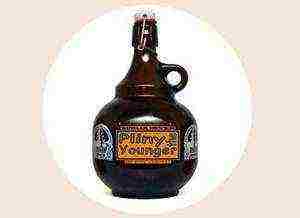
Some craft breweries like Russian River like to use the term triple IPA, for example, when referring to their Pliny the Younger (12% ABV and three times the hops of their regular IPA). Such monsters of aromas and bitterness usually require significantly more effort in production, and it is logical that brewers want to emphasize this, but the beer public does not support them and the term did not catch on. Doubles are enough for people.
Belgian IPA
The Belgian IPA came about after Belgian brewers were introduced to new American IPAs in the mid-2000s. They were struck by the richness of the taste and the overturning aroma, and, of course, they tried to create their own variation by hopping well the Belgian strong ales. Today, there are two types of Belgian IPAs: the heavily hopped Belgian ales and the American brewer's answer, American IPAs fermented with Belgian strains of brewer's yeast. Given how much Americans love and respect Belgian beer traditions, it is Belgian IPA that are now actively gaining momentum and may well become one of the beer trends of the coming year.
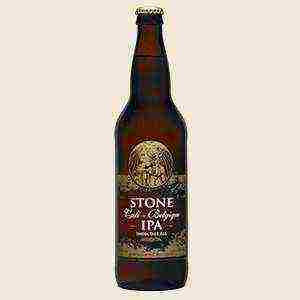
STONE CALI-BELGIAN IPA

FLYING DOG RAGING BITCH BELGIAN-STYLE IPA
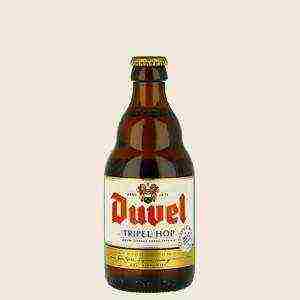
DUVEL TRIPLE HOP
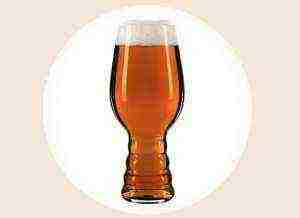
IPA today has its own unique tableware - Spiegelau, something very similar to a glass for a strong wheat flank of the aventinus. As for the more common tableware, moderate IPAs can be drunk from any pint, while for more aromatic strong IPAs, it is better to use tulips, cognac and wine glasses.
Black IPA
Black Indian Pale Ale is a relatively new variation, the name of which is a kind of oxymoron. Black IPAs are essentially double IPAs, but with the addition of darker types of malt. They are hopped primarily with American West Coast hops. Various historical sources indicate that dark beer was heartily hopped even during the dawn of the British Empire, but in its modern form, BIPA began to appear only in the same experimental 1990s. By the mid-2000s, Stone launched their 11th anniversary black Indian ale, which in 2007 entered their lineup of permanent beers. For most beer lovers, Stone Sublimely Self-Righteous Ale is the standard and pinnacle of this subtype. It tastes like an espresso infused with pine branches and sprinkled with ash on top.

STONE SUBLIMELY
SELF-RIGHTEOUS ALE
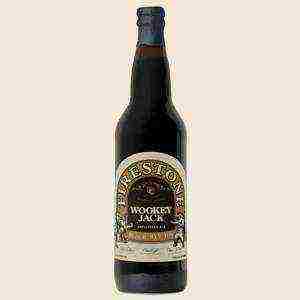
IRESTONE WALKER WOOKEY
JACK BLACK RYE IPA
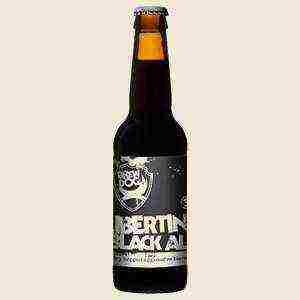
LIBERTINE BLACK ALE

Until recently, one of the names for black IPAs was Cascadian dark ale (after the region of the Cascade Mountains and the cascade family of hops), but recently beer lovers have begun to separate the two concepts.
Session IPA
One of the most recent IPA trends in the world, only emerging in 2010, is session ale. The problem is that in the pursuit of large bouquets, crafters began to raise the degree a lot and, in fact, turned the IPA into a strong dessert beer. After the euphoria from the big hops subsided, the people wanted something, maybe less drunk, but with a more sit-down degree. To stretch the pleasure. The brewers have shifted the addition of hops to the later stages of brewing and have been able to spawn a beer that ranges from 3.5-4.7% ABV, but stands out with a powerful hop flavor that clogs even slightly stronger American Pale Ales. This subspecies has no color and other divisions yet; American, New Zealand and experimental hops are used.

STONE GO TO IPA

FOUNDERS ALL DAY IPA

LAGUNITAS DAYTIME

Despite the fact that IPAs often use different types of malt, such as rye, oats and wheat, it has not yet been possible to classify Indian ales according to this characteristic. So far, things have not gone beyond single terms, like rye Rye IPA or wheat White IPA.
Single Hop IPA
One-hop or mono-hop Indian ales are quite a niche product that either hops aficionados or those who are fed up with complex IPAs are interested in. Usually in modern IPA they put from three or more varieties of hops, thereby forming a specific bouquet, but mono-hop ones are limited to one and thus demonstrate both the aromatic qualities of the variety and the specificity of its bitterness. This kind of hop benefit helps beer geeks get to know a particular variety better and sometimes creates a really interesting taste, but, in general, this is not a product for the masses.

BREWDOG IPA IS DEAD SERIES
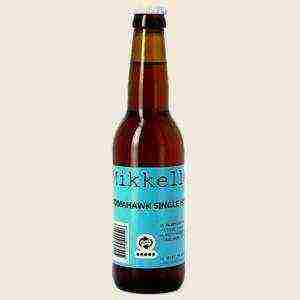
SINGLE HOP IPA BY MIKKELLER


